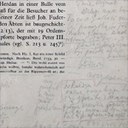0216 Under the Pressure of ‘Polonization’ Ideology: Renaissance and Baroque Art in Silesia in the Works of Polish Art Historians after 1945
Identifiers (Article)
Identifiers (Files)
Abstract
This article explores a neglected topic: Polish research into the Early Modern period of Silesian art under Socialism. Although this epoch has never been quite as popular as the Medieval period as a subject of art historical research, its position was to fall victim to the ‘re-Polonization’ efforts of Polish art historians during the period after Silesia had been incorporated into the Polish state. This paper gives an overview of the numerous studies on Renaissance and Baroque art and architecture that appeared in the period from the difficult first years after the Second World War until the early 1960s, when the phenomenon of ‘Polonization’ of Early Modern Silesian art began to subside. It raises issues relating to the compatibility of Communist and nationalist ideologies and seeks to give reasons for the stance taken by the art historians involved in the story.
Statistics


License

This work is licensed under a Creative Commons Attribution-NonCommercial-NoDerivatives 4.0 International License.



